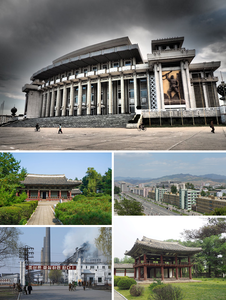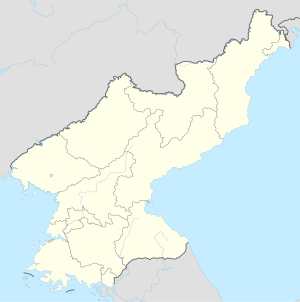Hamhŭng
| Hamhŭng | |||
|---|---|---|---|
| Korean alphabet : | 함흥시 | ||
| Chinese characters : | 咸興 市 | ||
| Revised Romanization : | Hamheung-si | ||
| McCune-Reischauer : | Hamhŭng-si | ||
| Basic data | |||
| Province : | Hamgyŏng-namdo | ||
| Coordinates : | 39 ° 55 ' N , 127 ° 32' E | ||
| Residents: | 668,557 (as of 2008) | ||
| map | |||
|
|||
Hamhŭng is a port city in North Korea with 668,557 inhabitants and the second largest city in the country after the capital Pyongyang . It is an industrial city, a transport hub and a cultural center with a university, theater and museums.
geography
The city is located on the east coast of North Korea on the Songchon River. The geographical coordinates are 39.92 degrees north and 127.54 degrees east.
In 2005, the urban area was politically expanded to include the city of Hŭngnam , located 13 kilometers south of the Sea of Japan .
history
During the Japanese colonial period (1910-1945) the city was expanded industrially. At this time it was called Kankō , which is the Japanese reading of the city name 咸興 市 .
During the Korean War (1950–1953), 80 percent of Hamhŭng was destroyed by air strikes by US bombers. After the war, it was further expanded as an industrial center. From 1954 to 1962, a group of architects and engineers from the GDR , the " Deutsche Arbeitsgruppe Hamhŭng ", were involved in the reconstruction of the destroyed city .
From 1960 to 1967 Hamhŭng was under central administration by the government. Hamhŭng has been the capital and part of Hamgyŏng-namdo province since 1967 .
Culture and sights
Interesting on the northern edge of the city is Tonghung Hill. There are a number of pavilions on top of it . One of them, the Kuchon Pavilion on top of Tonghung, is a relic from the Goryeo dynasty (918–1392).
The Sonhwa Hall is located on the old city wall at the foot of Tonghung Hill. It was built as a meeting place during the Joseon Dynasty (1392-1910) in the 15th century.
The beach of Hamhŭng is divided into a recreation zone, in which beach visits are possible on around 300 hectares and 25 kilometers in length. The lush vegetation provides plenty of shade, and the leisure area has swimming facilities, camps and various rest stops.
Economy and Infrastructure
economy
In the city there are aluminum processing, mechanical engineering, textile and chemical industries. In 1961 the large Vinalon factory “8. February “ in Hŭngnam.
Hamhŭng achieved dubious fame in the world when it was discovered that different chemical plants in the west and east of the city are dedicated to the production of pesticides , which can also be used as chemical warfare agents . Around Hamhŭng there are a number of coal mines and also a nuclear power plant.
Hana Electronics operates a larger branch in Hamhŭng.
traffic
Hamhŭng is an important traffic junction for road and rail traffic with a marshalling yard , port and airport. The port of Hamhŭng is located in Hŭngnam on the coast of the Sea of Japan. An important main thoroughfare is Jŏngsŏng Street .
education
The city is the seat of the Hamhŭng University of Education, Hamhŭng University of Chemistry and Hamhŭng University of Medicine. It houses numerous technical colleges and universities as well as libraries.
Trivia
The term Hamhŭng chasa ( 함흥 차사 , Mayor of Hamhŭng) literally denotes people who are too long in coming. It comes from the tradition that the mayor always of Hamhung of tigers have been eaten.
sons and daughters of the town
- Yang Hyong-sop (* 1925), politician
literature
- Christian Kracht, Eva Munz, Lukas Nikol: The total memory. Kim Jong Ils North Korea. Rogner & Bernhard, Berlin 2006. ISBN 3-8077-1020-5 .
- Arno Maierbrugger: North Korea Handbook. On the move in a mysterious land. Trescher, Berlin 2004, ISBN 3-89794-039-6
- Pang Hwan Ju, Hwang Bong Hyok: A Sightseeing Guide to Korea. Foreign Languages Publishing House, Pyongyang 1991
- Kim Sung Un: Panorama of Korea. Foreign Languages Publishing House, Pyongyang 1999
- Robert Willoughby: North Korea. The Bradt Travel Guide. Editions Bradt, Londres 2003, ISBN 1-84162-074-2
Web links
- Rainer Dormels: Hamhung - the center of Northeast Korea , 2014 (PDF; 1153 kB)
Individual evidence
- ↑ Central Bureau of Statistics (ed.): DPR Korea 2008 Population Census. National Report . Pyongyang 2009 ( un.org [PDF; accessed December 27, 2014]).
- ↑ http://www.nkeconwatch.com/category/dprk-organizations/companies/hana-electronics-company/





